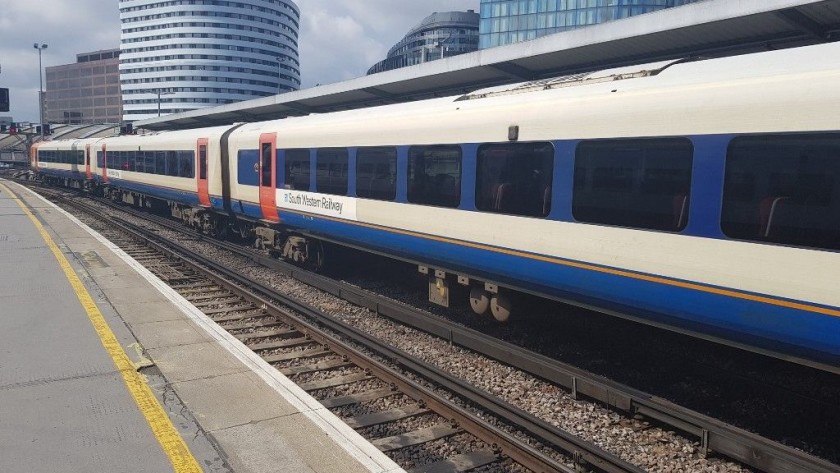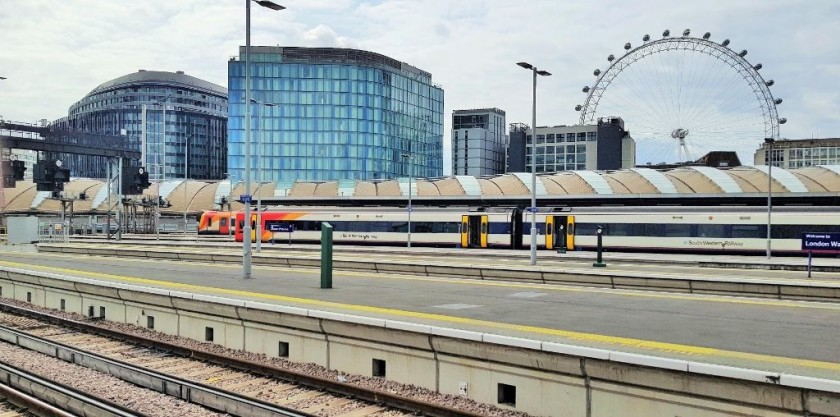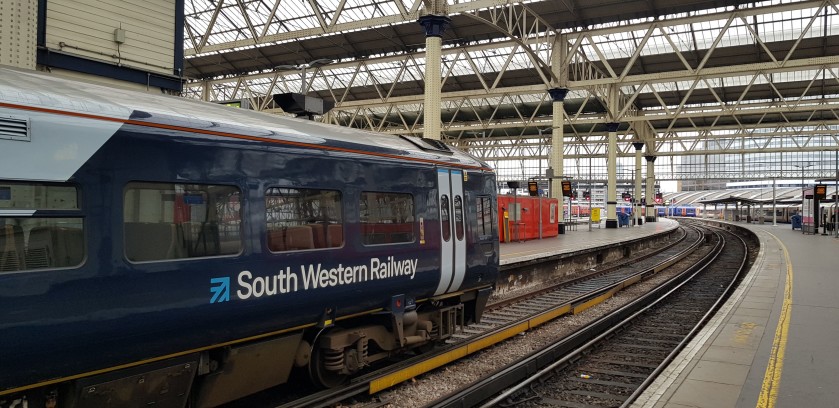Related Content
Content
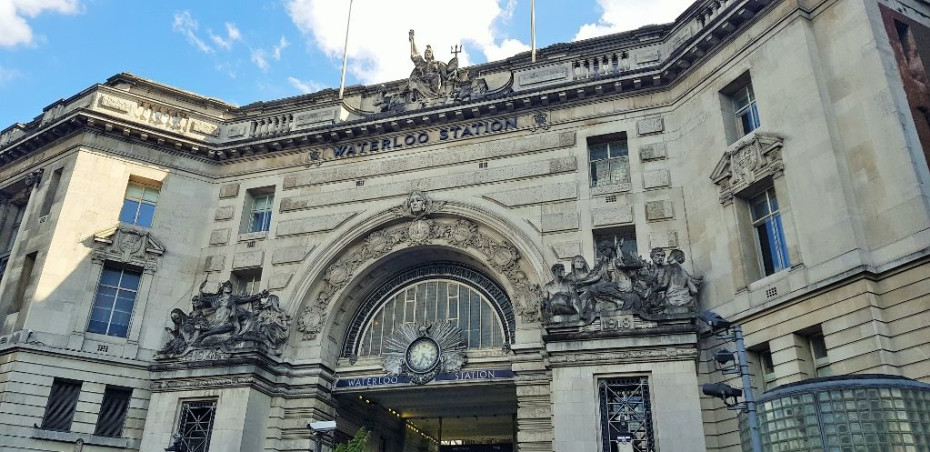
London Waterloo (London)
With its 24 platforms (tracks) London Waterloo is the UK’s largest station, but as it’s a terminus station the access to and from the trains is straightforward, so despite its size it is also a comparatively uncomplicated station to navigate.
Share
At a Glance
Services
Left Luggage
Travel Information Desk
Local Tourism Information
Onward Travel
Metro
Taxi Rank
Accessibility
Step Free
Misc
Terminus Station
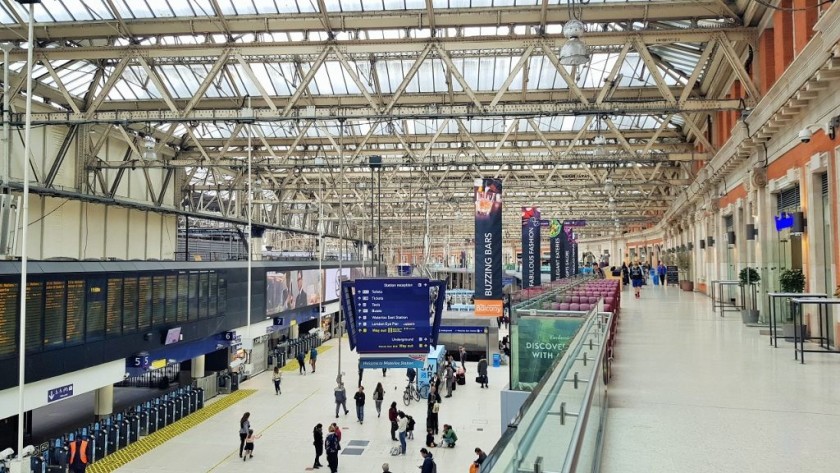
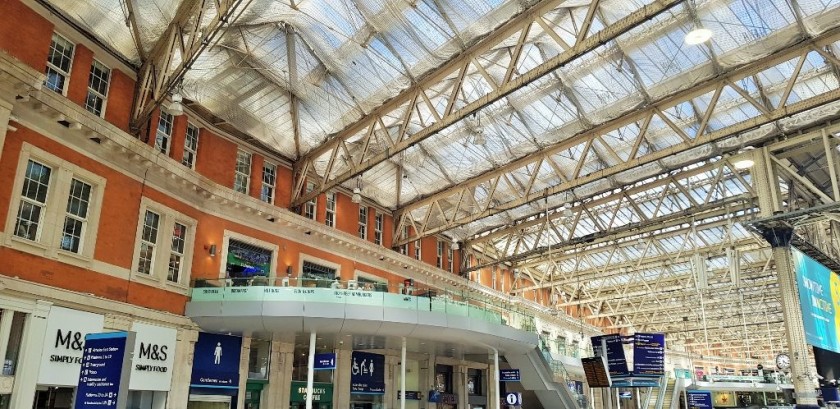
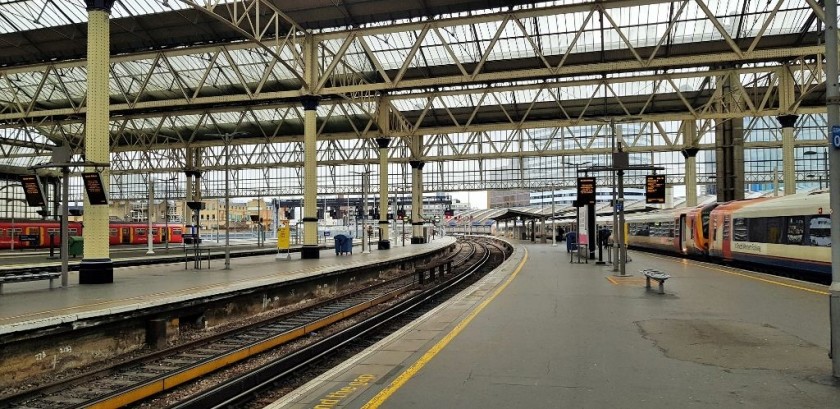
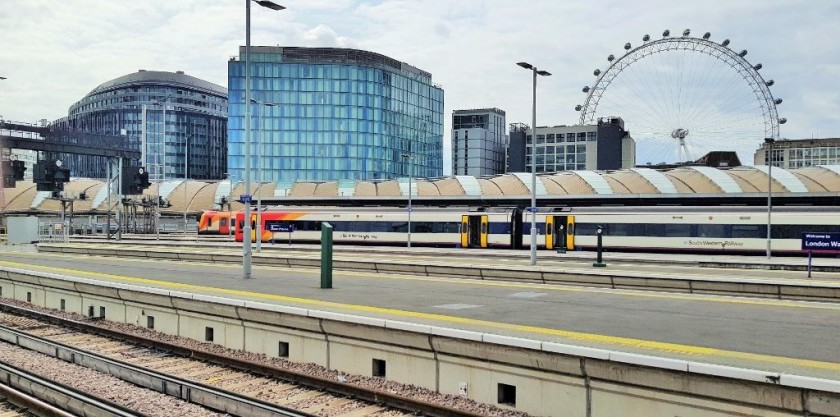
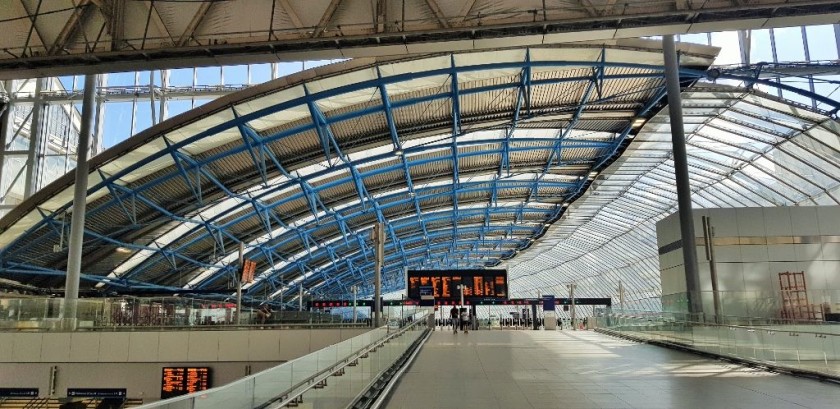
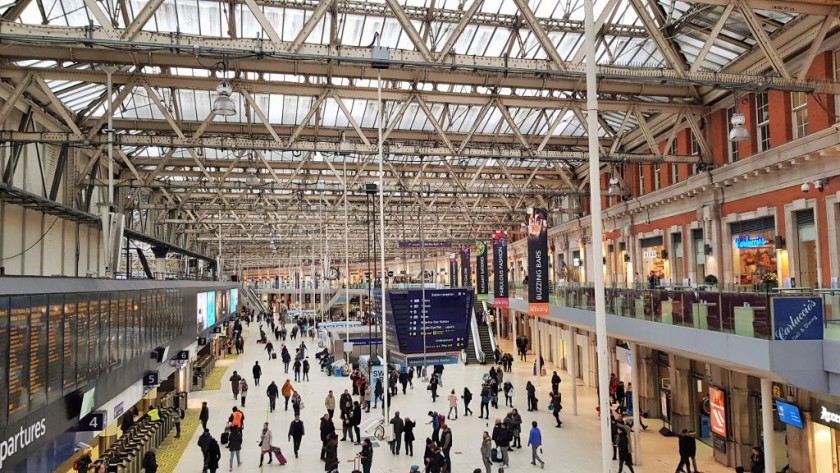
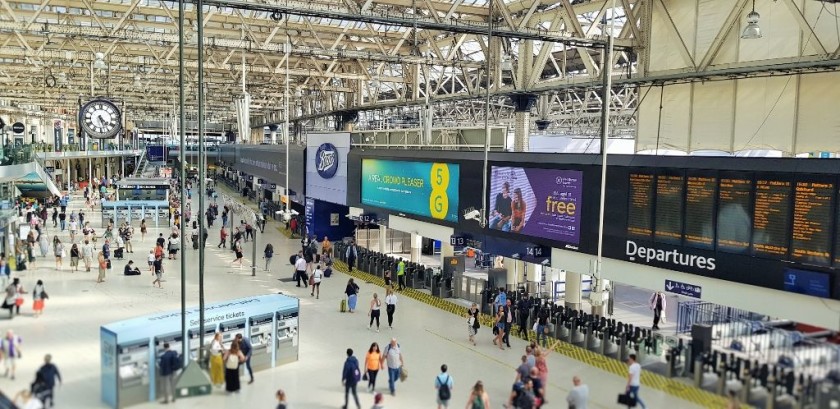
All of the platforms/tracks which the mainline trains arrive at and depart from are linked to the main concourse.
Although what was the Eurostar terminal has recently been adapted, so that it can now accommodate regular train services.
As a result the access to platforms (tracks) 20-24 is set back from the main concourse; and the transfer between the Underground and this part of the station is by a different route, which avoids the main concourse.
What can help make sense of the space is that the trains usually depart from specific sets of platform (tracks) according to their destination, though note there’s some overlap.
Platforms 1 – 6 for the shorter-distance ‘commuter trains’ via Wimbledon to Hampton Court, Chessington, Epsom and Kingston-upon-Thames.
Platforms 5 – 17 are used by the longer-distance to trains to destinations including Bournemouth, Exeter, Portsmouth, Portsmouth, Salisbury, Southampton and Winchester.
Platforms 17 – 24 are where the trains to Ascot, Putney, Richmond and Windsor depart from.
Train service summary:
The typical pattern of train departures from Waterloo station to popular tourist destinations is:
- to Alton for the Mid-Hants Railway and Arundel = 2 x trains per hour from platforms 5 to17
- to Brockenhurst = 2 x trains per hour from platforms 5 to17
- to Bournemouth = 2 x trains per hour from platforms 5 to 17
- to Chessington South for the World Of Adventures = 2 x trains per hour from platforms 1 to 6
- to Hampton Court = 2 x trains per hour from platforms 1 to 6
- to Portsmouth = 2 x trains per hour via Guildford from platforms 5 to 17
- to Richmond = 6 x trains per hour from platforms 18 to 24
- to Salisbury = 2 x trains per hour from platforms 5 to 17
- to Weymouth = 2 x trains per hour from platforms 5 to17
- to Winchester = 3 x trains per hour from platforms 5 to17
- to Windsor & Eton Riverside = 2 x trains per hour from platforms 18 to 24
All trains are operated by South Western Railway.
Live departures can be looked up here
Waterloo East station
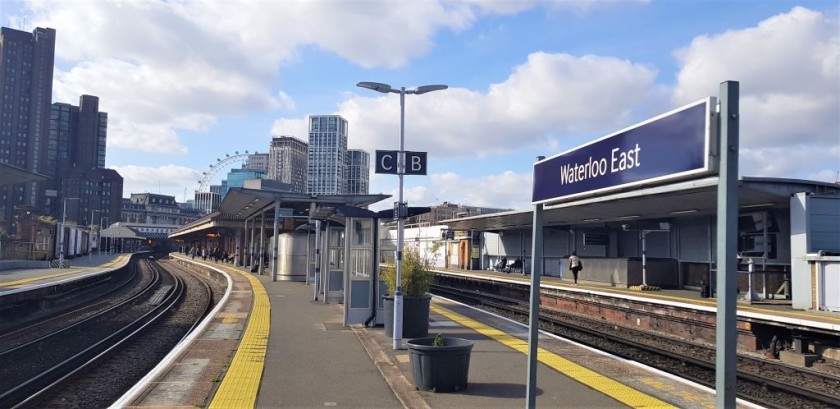
Waterloo East is a separate station which is connected to the main terminal by a footbridge, which can be accessed from an upper 'balcony' level in the main station.
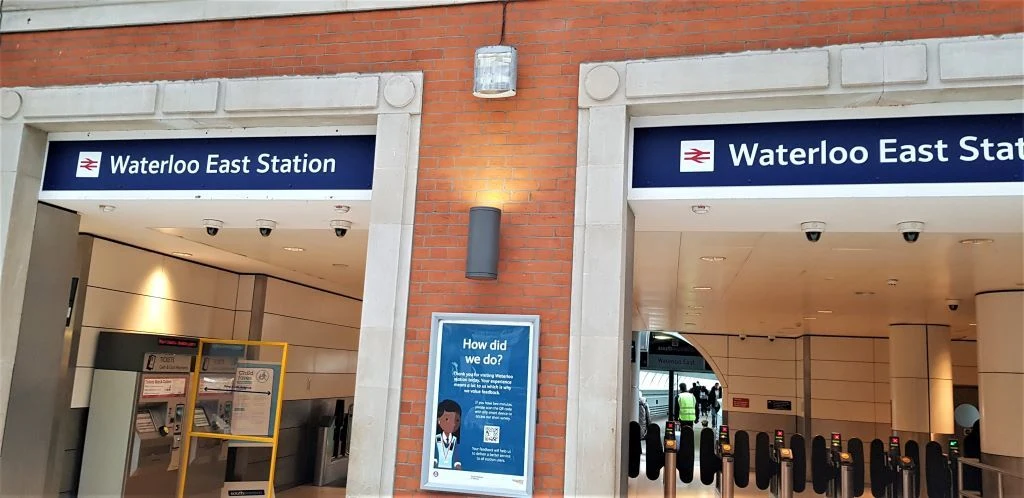
This upper level across the rear of the terminal, also houses some of the best places to have something to eat and drink while waiting for a train at Waterloo.
The access to this upper level is by either using one of the two sets of escalators, located at either end of the concourse...
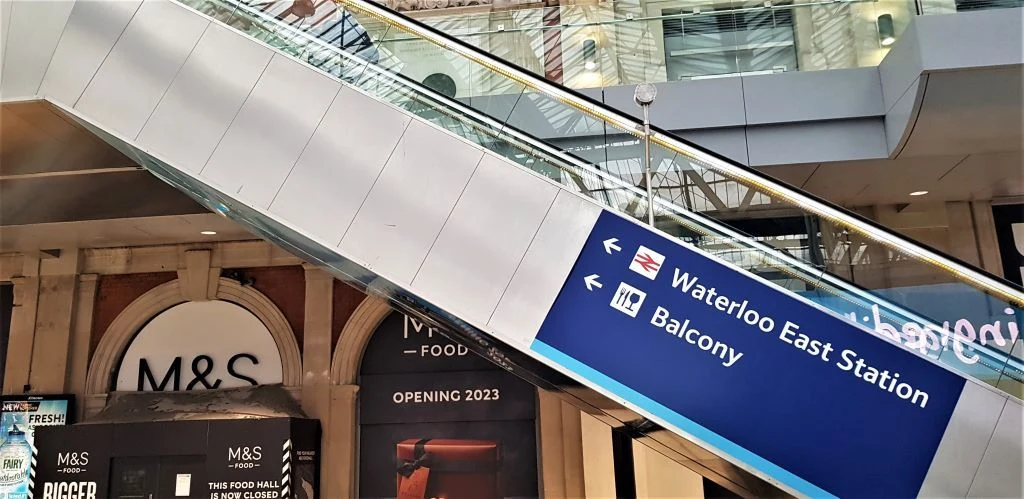
...or by using the lift (elevator) on the rear wall of the station, which can be found opposite platforms 9 and 10.
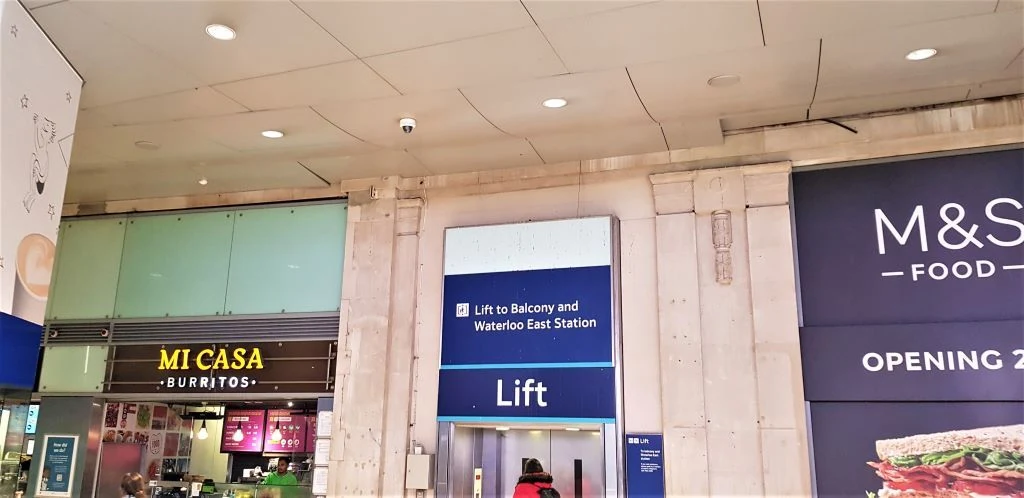
Waterloo East station is used by Southeastern trains to Canterbury, Dover, Hastings and Tunbridge Wells, all of the trains from Waterloo East also call at London Bridge station.
Though if you’ll be taking the Jubilee Line to connect to these trains, alight at Southwark station instead of Waterloo.
Questions Answered
ShowMeTheJourney has anticipated what questions are most often asked about taking trains to and from Waterloo station and answered them below.
If you can't find the information you are seeking, you can ask a question and the AI enabled service will try to write an answer, telling you what you wish to know.
Is there step-free access to and from the platforms / tracks?
Yes, Waterloo is a terminus / stub station so when arriving and departing you can simply walk from and to the trains.
How to travel between Waterloo and the city centre
Waterloois located is on the south bank of the River Thames but despite that the station has easy access to central London.
The River Thames bends as it travels through the city and thanks to this quirk of geography. many parts of the city centre can be unexpectedly closer to Waterloo than you might suppose.
Waterloo is also right by the dynamic South Bank area of the city.
A pedestrian walkway is available on the south side of Thames as far east as Tower Bridge and to reach it:
- Use the main exit from Waterloo at the end of the concourse; opposite the bridge to platforms 20-24 -follow the street signs pointing the way to the Festival Hall.
- Go down the stairs and follow the crowds will be heading over to the left, cross the street, go under the railway bridge and head to Festival Hall.
- On the other side of the Festival is the path by the river.
- For Covent Garden head right and then cross over the first bridge, Waterloo Bridge - in around 20 minutes
- For Westminster go left by the London Eye and cross over Westminster Bridge - in around 15 minutes
- For Tate Modern go right and you will be there in around 15 minutes, you can cross the Millennium Bridge to St Pauls cathedral - around 20 mins in total
To the West End
London's most popular shopping and entertainment district is easily accessible from Waterloo.
Trafalgar Square is around a 15 min walk from Waterloo, use the footbridge to the left of the Festival Hall beside the railway tracks, and the route will take you to Charing Cross station.
- The Bakerloo line connects Waterloo with the Underground stations at Piccadilly Circus; and Oxford Circus.
- The Jubilee line goes to and from Green Park and Bond Street.
- The Northern line connects Waterloo with Leicester Square and Tottenham Court Road.
The overwhelming majority of trains to Waterloo also call at Clapham Junction station and from platforms 12 and 14 at this station, there are frequent trains to Victoria Station
That station has more convenient access than Waterloo to the western side of central London.
So if you’ll be heading to Knightsbridge, St James’s Park or Hyde Park it can be worth considering making the connection at Clapham Junction.
Or if your train will be calling at Vauxhall, the longer-distance trains skip this station, it has an easy interchange with the Victoria Line of the Underground – and this line doesn’t serve Waterloo.
To the museum district
If you’ll be heading to South Kensington for its museums and on a train which calls at Wimbledon or Richmond, the best option is to connect at those stations into a District Line train.
To the other tourist attractions
London's galleries, historical landmarks, markets and museums are scattered across the city - hence this guide on how to reach them by public transport from Waterloo.
How can tickets purchased for the public transport connections?
The cheapest and easiest options for travelling to / from Waterloo by public transport is to avoid buying tickets and to use Contactless payment instead.
Regardless of whether you are resident in the UK, or are visiting, there are three methods of using Contactless:
- A payment app on a mobile device, including your bank's contactless payment app, or the likes of Google Pay, Apple Pay, or Samsung Pay.
- A debit / credit card as long as it has the contactless symbol (some non-UK cards with the symbol are also an exception - particularly when visiting from the Canada. the USA and The Netherlands, so it's worth confirming with your bank prior to arrival in London).
- An Oyster card (you touch in and out as you do when using Contactless).
More info is available on the general guide to travelling in London by train.
How to access the other London stations from Waterloo
The other major London stations which host long-distance rail services are some distance from Waterloo, hence this guide on how to make the transfers when taking cross-London journeys.
How to travel between Waterloo station and Heathrow Airport
All of the trains to and from the main Waterloo station follow routes to destinations that are south and west of London and Heathrow Airport is also to the west of the city.
Hence when travelling between Heathrow and locations which are served by trains on the lines to / from Waterloo, the easier option is usually taking a Rail Air Link bus, which operate on routes to/from Guilford station and to/from Woking station.
More info is [available on this guide]/travel-info-and-tips/airport-rail-links-in-great-britain/).
The bus link is popular because the transfer between Waterloo station and Heathrow Airport is indirect.
The quickest and easiest option, it is step-free, is to take the Jubilee line between Waterloo and Bond Street to make transfers there in and out of the Elizabeth line.
Are there cafes or restaurants available?
Because Waterloo station is primarily used by commuters it lacks a restaurant offering a full meal service, but numerous outlets are available which sell coffee, fast food, snacks and sandwiches.
Are there left luggage facilities?
Yes there is a facility managed by The Excess Baggage Company, which is located at the back of the concourse, on the right when facing the trains.
It is opposite the walkway which leads to platforms / tracks 22 - 24.
Is there a first class lounge?
No.
Departing by train:
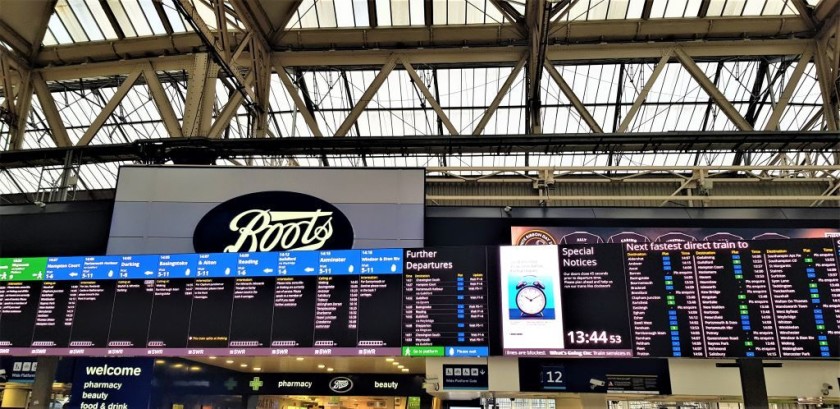
Taking a train from London Waterloo is comparatively straightforward, though due to the size of the station it’s always a good idea to be there at least five minutes before your train departs.
As seat reservations in the conventional sense aren’t available on any train which leaves Waterloo, if you want to be sure of a seat for your journey, it’s best to be on the concourse and ready to board with your ticket, a minimum of 15 minutes before the train you will be taking will be leaving.
Checking the departure info:
The platform (track) number for each departure will appear on the main departure boards, the concourse is so large that there are now three sets of them, around 10 – 15 minutes prior to departure.
The details of the destination and the calling point of each train will appear first, the departures move across these screens in sequential order, so the details of the train will initially appear on the right.
The platform (track) number will be added later without any fanfare, it usually won’t be announced, so keep an eye on the screens.
A new set of departure boards have recently been placed in the middle of the concourse.
Or you can ensure you’ll be waiting close by the platform that your train will be leaving from, if you will be heading to destinations including Hampton Court, Chessington, Epsom and Kingston-upon-Thames, wait in front of the departure screens above the entrances to platforms 3 – 7.
If you’re going to Ascot, Putney, Richmond and Windsor wait in front of the departure screens above platforms 14– 17.
However, if you’re heading to Bournemouth, Exeter, Portsmouth, Salisbury, Southampton or Winchester, use that central set of departure screens, pictured above, as the trains to these destinations use a mix of platforms across the middle of the station.
Boarding the trains
Something else to watch out for is that two trains serving different destinations can be joined together on departure from Waterloo, the trains will be divided during the journey.
So pay attention to any information alerting you to where specific coaches on a train will be heading to.
And then where you are walking along the platform to board the train, some basic counting may be required, so that you can find the ‘front four coaches’ etc.
Also the trains nearest to the entrances to the platform may not be going anywhere soon, but the train you will be taking will be leaving from the far end of the platform.
This is also another reason for not having to hurry against the clock when taking a train from Waterloo, many of the trains leaving Waterloo are 12 coaches long, so having to rush down to the more distant far end of a platform is a scenario best avoided.
Also try to avoid taking any train from London Waterloo between 16:30 and 19:00 on Monday – Friday.
All of the routes from the station are popular with commuters, so both the stations and trains become a lot busier and crowded during these times.
Arriving by train:
If you won’t be arriving by train at Waterloo in the morning rush hour*, the only usual means of accessing the exits from the station and the Underground, is to go ahead from the train and pass through the ticket gates on to main concourse.
(*If your train arrives at platforms 1 – 18 between 07:00 and 10:00, you’ll be able to access staircases which are a short-cut to the Underground station).
Though if your train arrives at the newly re-opened platforms (tracks) 20 – 24, there are escalators on these platforms, which provide a quicker route to the access to the Bakerloo, Northern and Waterloo and City lines.
Connecting to the Underground:
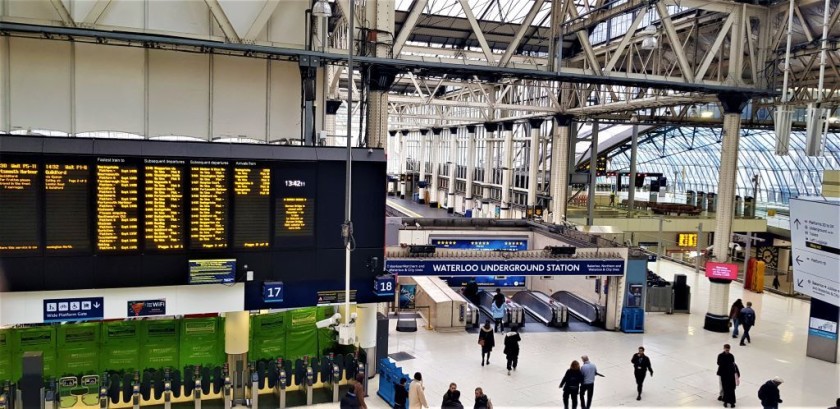
There are three entrances to the Underground station on the main concourse, that opposite platforms 4 -5 is the quickest route to the Jubilee Line.
The shortest route from the concourse to the Bakerloo and Northern lines, is to use the entrance to the Underground which is beside the entrance on the concourse to platform (track) 17, which is pictured above.
By platform 4 and 5 on the concourse is this alternative route to all four of the Underground lines, which serve Waterloo.

It provides the quickest access from this side of the station to the Waterloo and City line, which on Mondays to Saturdays provides a one-stop hop to Bank station, but avoid it if you'll be taking the other lines as it isn't a short-cut.
Something also worth being aware of is that step-free access is available to the Bakerloo, Jubilee and Waterloo & City lines, but the platforms that the Northern line trains use can only be accessed by using a short flight of stairs.
The Bakerloo line
The Bakerloo line connects Waterloo to
- Piccadilly Circus for Soho and the theatres on Shaftesbury Avenue
- Marylebone; and
- Paddington stations.
The Jubilee line
The Jubilee line connects Waterloo to:
- Westminster,
- Green Park for the street named Piccadilly and Mayfair,
- Bond Street for Selfridges,
- Baker Street for Madame Tussaud’s,
- London Bridge for Borough Market and The Shard: and
- North Greenwich for The O2.
The Northern line
The Northern line connects Waterloo with
- Leicester Square for Covent Garden,
- Tottenham Court Road and;
- Euston station.
to Kings Cross, St Pancras
If you’ll be heading to Kings Cross or St Pancras stations from Waterloo there is no direct link by Underground, but of all the options available, SMTJ’s preferred route is to take the Bakerloo Line to Piccadilly Circus and then transfer to a northbound Piccadilly Line train.
The Bakerloo Line tends to be quieter than the other Underground lines and an escalator link is available between the two lines at Piccadilly Circus.
For various reasons avoid taking the Northern Line to Warren Street and connecting there for the Victoria Line.
Taking a bus from Waterloo
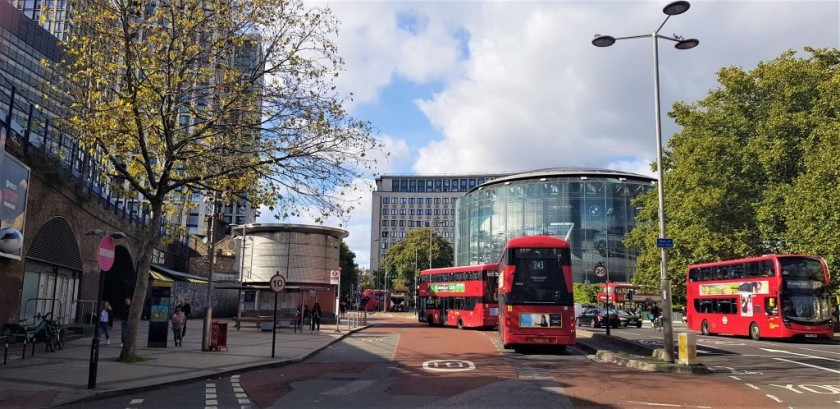
Taking a bus into central London can be good option from Waterloo, as they serve many areas of the city centre which can't be directly reached by Underground,
There are bus stands by the station, though they are out of sight from any of the station exits.
The bus stops located here are used by routes/lines which head north to Holborn and beyond, which is the 1, 68, 139, 159, 168, 176, 188, 243 and 521.
Find them from the Victory Arch exit, by heading down to the main road, you'll see in front of you and then turn right.
Or head down to the exit on Waterloo Road, through the Jubilee line ticket hall, turn to the left once you're outside the station and walk ahead under the bridges which span the road.
Though other useful routes use other bus stops scattered around the station.
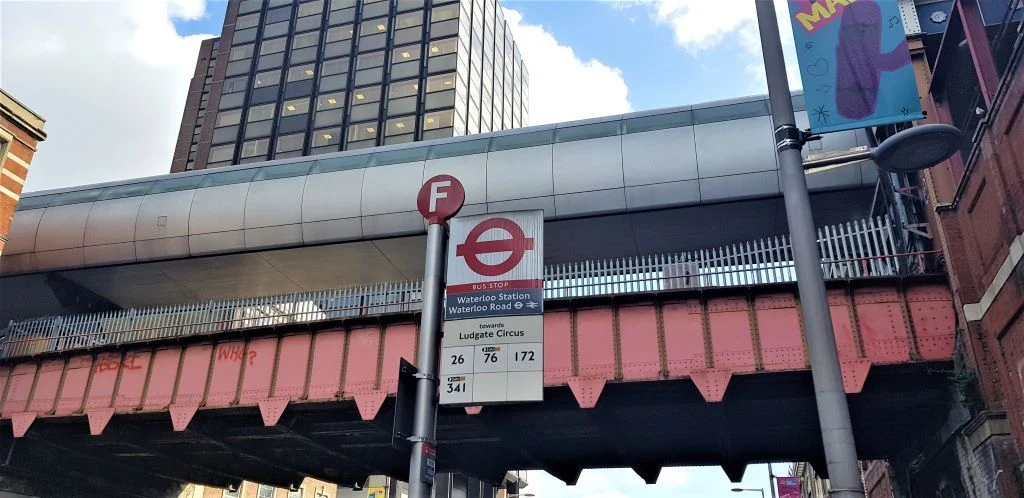
From stop F on Waterloo Road, buses head to The Royal Courts of Justice, Fleet Street, St Paul's. Liverpool Street, Saddler's Wells Theatre, and The Angel, Islington.
Guides to travelling by train in London
Making transfers to and from other major London stations
Please support ShowMeTheJourney
This second version of ShowMeTheJourney is exciting and new, so we are genuinely thrilled that you are here and reading this, but we also need your help.
We’re striving not to let anything get in the way of providing the most useful service possible, hence a facility has been set up with DonorBox which can be used to support the running costs and make improvements.
Instead of advertising or paywalls, your financial support will make a positive difference to delivering an enhanced service, as there’s a lot of ideas which we want to make happen.
So if you have found the info provided here to be useful, please go here to say thank you.
Journeys
# Jump to a directionDirections
Journeys from London Waterloo
Jump to directionsLondon to Bournemouth by train
London to Exeter by train
London to Portsmouth by train
London to Salisbury by train
This second version of ShowMeTheJourney is exciting and new, so we are genuinely thrilled that you are here and reading this, but we also need your help.
We’re striving not to let anything get in the way of providing the most useful service possible, hence a facility has been set up with DonorBox which can be used to support the running costs and make improvements.
Instead of advertising or paywalls, your financial support will make a positive difference to delivering an enhanced service, as there’s a lot of ideas which we want to make happen.
So if you have found the info provided here to be useful, please consider saying thank you.

This is one of more than 100 train travel guides available on ShowMeTheJourney, which will make it easier to take the train journeys you want or need to make. As always, all images were captured on trips taken by ShowMeTheJourney.






